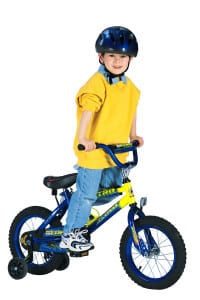Tips
Bicycle Helmets
It is very important to teach kids to wear a bicycle helmet every time they ride, even for short rides.
A bike helmet should fit properly (not too big or too small), and should be the only thing on the child’s head. If you’re unsure if the helmet fits, take it to a bike store for an evaluation.
Bike helmets should be worn level and cover the child’s forehead, and the straps should always be fastened. Make sure the straps are adjusted so they’re snug enough that you can’t pull or twist the helmet around on your child’s head.
Burns
When using the stove and oven, move young children to a high chair in the kitchen within reach or sight. Toddlers can move very quickly to reach for an open oven door, or can cause you to spill boiling or hot liquids if they get under foot.
When cooking around older kids, use only the back burner of your stove and turn pot handles away from the edge. Keep hot foods away from the edge of your counters. Additionally, it’s important to keep the water heater to 120◦ Fahrenheit or the manufacturer’s recommended setting to prevent scalding from showers and faucets.
Choking
Children under 5 are especially at risk for choking on food or toy parts. It’s important to cut food for toddlers into small pieces, and they should not eat small, round or hard foods, including pieces of hot dogs, cheese sticks or chunks, hard candy, nuts, grapes, marshmallows or popcorn.
Consider your child’s age when purchasing a toy or game, and read warning labels to make sure the toy is right for your child. Check the child’s toys to make sure broken pieces are not loose. Make sure toys for older siblings are not available to toddlers and babies if there are small parts.
Guns
It is estimated that about one third of households with children ages 18 and under have a gun in the home. Gun safety in the home starts with proper storage. All guns need to be in a locked location, unloaded and out of the reach and sight of children. Store the ammunition in a separate locked location, out of the reach and sight of children. Keep the keys and combinations in a different location from the guns, and hidden from children. When a gun is not in its lock box, keep it in your line of sight. Finally, make sure all guns are equipped with effective, child-resistant locks.
Obesity
The number of children who are considered obese is growing at an alarming rate. Many kids are spending less time exercising and more time in front of electronic screens. Additionally, the ease of fast food and convenience foods means that busy adults are making poor food choices for their children. It is easiest to prevent obesity in children by helping kids lead healthy lifestyles by example. Children should get 60 minutes of exercise every day, which might mean adapting the way the family spends time together. Additionally, parents should remember that they are in charge of the food that comes into the house. Children can learn to eat foods that they may say they don’t like.
Pedestrian Safety
Pedestrian injuries and death are most common among children between age 5 and 19, with teens being the greatest risk. With electronic devices such as cell phones and iPods, kids may be especially distracted. Talk to kids about using sidewalks or paths and to use traffic signals and crosswalks. Teach kids at an early age to put down their devices and then look left, right and left again before stepping into the road. We recommend that children under 10 should cross the street with an adult because it can be hard for kids to judge speed and distance of moving vehicles.
Poisoning
Most parents store medicine out of reach of children, but they may not think about products such as diaper rash creams, vitamins or eye drops and other similar items as medicine. Consider products you might not think about as medicines and store them safely out of reach. Be aware that many pills look like candy to children that you might think are old enough to not worry about. Talk to your child about the dangers of putting anything in their mouth if they don’t know what it is. Put the toll-free Poison Help Number into your home and cell phone: 1-800-222-1222 and on the refrigerator or another place where babysitters can see it. This number is not just for emergencies; anyone with questions can call for more information about administering medicine to children.
Spider Bites
The good news is that most spiders are harmless, and they rarely bite unless they feel threatened. However, two spiders are poisonous: the brown recluse spider (which is small, oval, and has a violin-shaped mark on its back) and the black widow (which has black body and an orange hourglass shape on its underside). The brown recluse bite can cause swelling, changes in skin color and a blister. The black widow spider bite can cause nausea, vomiting, chills, fever, and muscle aches. If your child has any of these symptoms – or you know that she’s been bitten – go to the emergency room right away.
For other spider bites, you can expect a similar reaction to a bee sting.
- Keep the area clean by washing with soap and water several times a day until it heals.
- Apply antibiotic ointment
- May use age-appropriate dose of acetaminophen or ibuprofen if your child complains that the bite hurts.
- Call the doctor if symptoms of infection develop (redness, swelling, pus, a warm feeling around the bite).
Strangers
Teach children that if they feel uncomfortable for any reason, it is OK to say no and get away and to not be polite to strangers. Reiterate that grown-ups will not ask children for help if they need it. It is never OK to take anything or go anywhere with anyone they don’t know. Make sure your child can recite their name, address and home phone numbers (including both parents’ cell numbers). Parents should refrain from writing the child’s name on the outside of clothing or on lunch boxes and other items that can be spotted by strangers. Teach your child that if they ever get separated from you in a public place, they should freeze and yell or go to a mom with kids to get help.
Sunburns
Prevent harmful UV exposure by limiting outdoor activities during the middle of the day, especially in the summer, or only allow outdoor play if it is in the shade. Use sunscreen with at least SPF 30 and UVA and UVB protection every time your child goes outside, even on overcast days. For the best protection, apply sunscreen generously 30 minutes before going outdoors. Don’t forget to protect ears, noses, lips and the tops of feet. Children who are fair skinned may also need hats or loose-fitting long sleeves. Reapply hourly to prevent burning.
